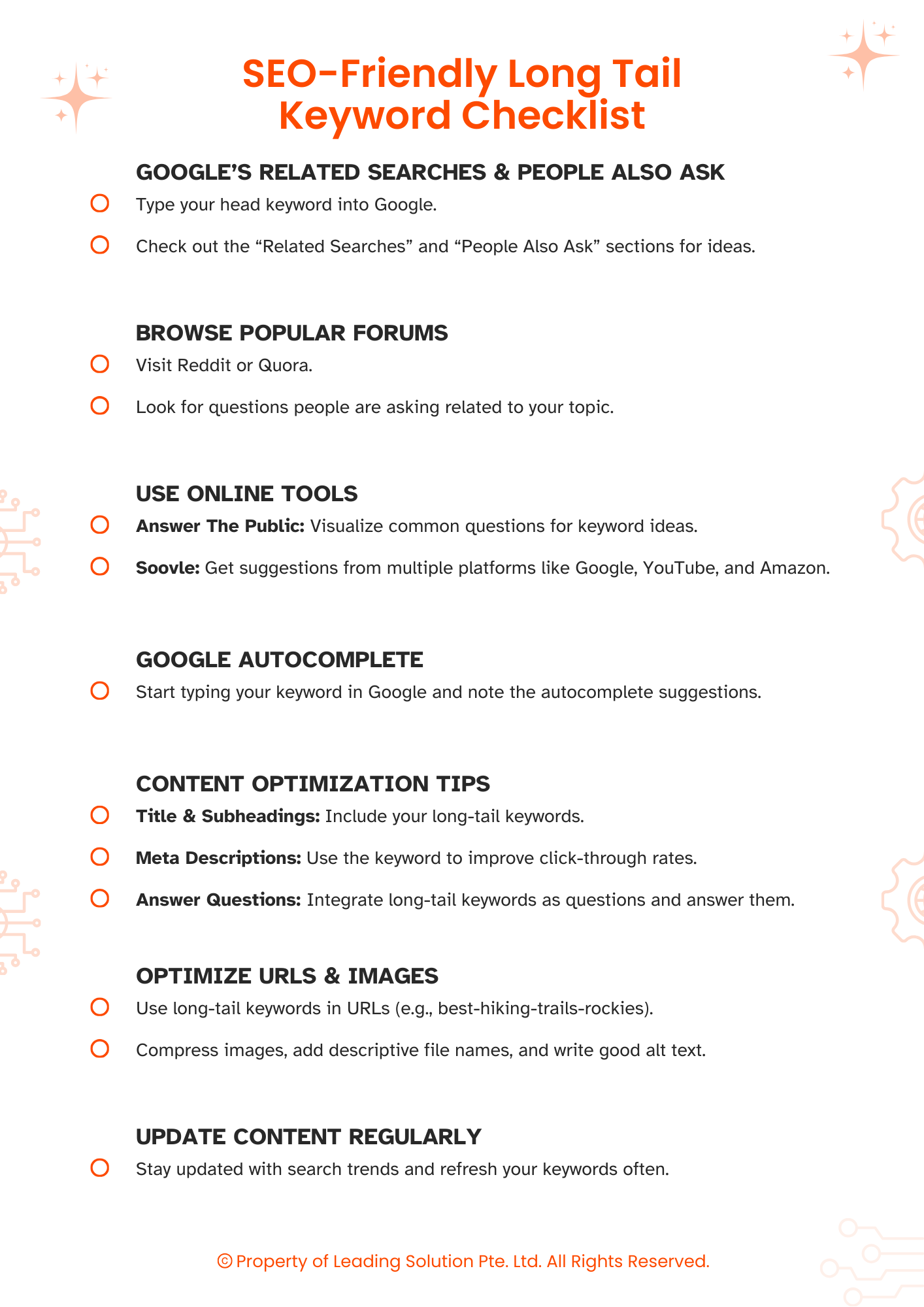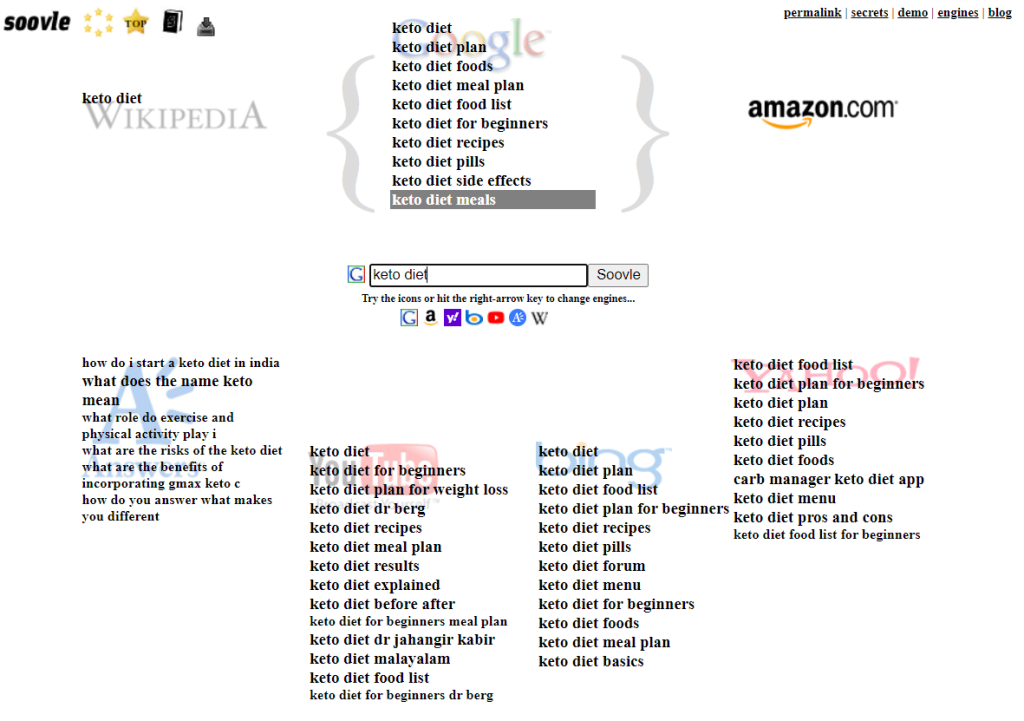To make things easier, here’s a downloadable checklist that you can use to implement these steps effortlessly.

Imagine you’re searching for “chocolate cake recipes for beginners” instead of just “cake recipes.” That’s a long tail keyword for you – more specific, less competitive, and highly effective in drawing in the right audience.
Visualize a graph where “cake recipes” shows a high search volume but a broad audience, whereas “chocolate cake recipes for beginners” targets a narrower, more engaged group. This distinction is crucial for creating content that ranks well and aligns with your targeted audience.
Long tail keywords have become one of the most powerful SEO strategies in today’s SEO market. Recent data shows that searches with four or more words have a 2.5 times higher chance of converting users into customers.
This article will cover everything you need to know about long-tail keywords. Thus, read this article till the end to get all the answers to your query.
What are Long Tail Keywords?
A Long tail keyword is a phrase that contains three or more words. In other words, they are search words with lower competition levels and search volume.
Long tail search keywords are less competitive and have more target keywords than short-tail keywords, making them easier to rank in search engines.
These keywords are called “long-tail” because they fall into the long, thin part of the “search demand” curve. It represents many unique searches that might be done a few times on any given day.

Long-tail keywords are also important for voice search optimization, as people use longer, more conversational phrases when using voice search. Using long-tail keywords in your content can help you rank better in these searches, improve your site’s traffic, and increase your conversion rate by targeting users with specific intents.
In general, long Tail Keyword:
- Is more specific
- Have a lower search volume
- Higher conversion Potential
Examples of Long-Tail Keywords
Let’s see how the long-tail keyword is different from the main keyword:
#Example 1
- Main Keyword: Often consists of one or two words representing a broad topic or category. For example, “shoes” or “running shoes.”
- Long-Tail Keyword: Typically, it consists of three or more words that form a phrase describing a more specific aspect of the main keyword. An example related to the main keyword “shoes” would be “women’s waterproof running shoes.”
#Example 2
Main Keyword “Laptops”
The keyword is a very broad term. It will have a high search volume. However, it is also highly competitive and needs more specificity, making it hard for smaller sites to rank high in search engine results.
Users searching for this phrase may be looking for anything relating to laptops, from shopping instructions to troubleshooting tips, with no specific intent.

Long Tail Keyword “Best Gaming Laptop Under $1000”
This long-tail term is significantly more particular, indicating that the customer is looking for gaming laptops in a specific price range.
It targets a specific audience, lowering competition and boosting the chances of attracting users who are further along in their buying journey and more likely to convert. This keyword is more accessible to rank for than the broad term “laptops” and will likely attract traffic related to the site’s content or products.

Long Tail Keywords Vs Short Tail Keywords
| Aspect | Long-Tail Keywords | Short-Tail Keywords |
| Length | Consists of three or more words, often forming phrases | Typically, one or two words representing broader topics |
| Specificity | Highly specific, targeting narrow audience segments | Broad and general, appealing to a wide audience |
| Competition | Lower competition due to specificity | Higher competition as they are more common |
| Search Volume | Lower search volume but higher conversion potential | Higher search volume but lower conversion potential |
| Ranking Difficulty | Easier to rank for in search engine results pages (SERPs) | More challenging to rank due to the high competition |
| User Intent | Reflects more focused user intent | It may capture users with varied intentions and interests |
Importance of Long Tail Keywords SEO in Singapore
Long-tail keywords are crucial for SEO in Singapore because they bring in highly targeted visitors, boosting conversion rates. Here’s why they’re so valuable:
Better Conversion Rates
The critical point of long tail keywords is they are specific rather than just longer.
When people use longer, more specific phrases to search, they’re usually closer to making a decision. This means they’re more likely to take action, like buying something, joining a newsletter, or reaching out through a contact form.
For example,
consider “plant-based recipes.” It’s a general search by someone curious about incorporating more plants into their meals, but they might still need a specific plan or goal.
Switch that up to “easy plant-based meal prep for the week.” This searcher is a step ahead; they’re not just interested in plant-based eating but are actively seeking practical solutions to integrate it into their weekly routine. They’re likely ready for a cookbook or a meal prep guide purchase.
Thus, using these longer search terms can help to boost traffic and convert the leads.
Lower Competition
The more specific the keyword, the less competitive it is. Long-tail keywords are less competitive than short or head keywords.
Businesses can achieve higher rankings in SERPs with minimal effort by targeting long-tail keywords.
Besides, the Cost per Click for long tail keywords is lower because of lower competition.
When you focus your AdWords campaigns on longer and more specific long-tail keywords, you can improve your ad rankings on searches that are highly relevant to your business. This means you can rank higher without spending a lot on every click.
The key is to discover a consistent and sustainable supply of long-tail keywords that suit both your needs and your niche.
Let’s understand through the example below:
For the head term” SEO strategy,” you have to compete with about 295 million other sites to rank number 1 on Google.

While on the other hand, see the long tail keyword “SEO strategies for e-commerce business.”
The long tail keyword has less competition than the head term itself.

Voice Search
As voice search becomes more popular, long-tail keywords are gaining importance. When people use voice search, they tend to speak in longer, more natural phrases, similar to long-tail keywords.
By optimizing for these words, you can improve your online visibility and appear in voice search results.
How to Find SEO-Friendly Long Tail Keyword?
#1 Google’s Related Searches and People Also Ask.
This is a quick and easiest method to find the long tail keyword. Just insert the head term, and Google will provide you with the most searched terms or queries by people.
These queries are the perfect long-tail keywords to add to your content to secure your position in Google or any other search engine.

And,

#2 Browse Popular Forums
Places where people discuss, like Reddit or Quora, are gold mines for long-tail keywords. Look for questions related to your main topic. What are people asking? How do they phrase their questions?
Some questions might have high-volume keywords, or you can even brainstorm new keyword ideas from the search queries.
These are real-world long-tail keywords from which you can create topic ideas and have quality content.
#3 Using Online Tools
It visualizes the questions and phrases related to your primary keyword. This long tail keywords finder tool is excellent for generating content ideas based on people searching queries. It is perfect for uncovering the long-tail keyword.
Soovle
Soovle is a feel online long tail keywords generator tool that helps to find the long tail keyword. It collects keyword suggestions from Google, Wikipedia, YouTube, Ask.com, and Amazon.
After you enter the main keyword related to your niche, its search bar will automatically provide a list of keyword suggestions from various platforms.
This way, you can have the idea of long-tail keywords.

#4 Google’s Autocomplete
It is a predictive method of search queries. Start typing the main keyword related to your topic in Google’s search bar. There, you can see the auto-complete suggestions.
They are the long-tailed keywords that the users frequently search for.

Content optimization with Long-Tail Keyword
Using long-tail keywords is a clever strategy to enhance your SEO and engage directly with the people you want to reach. Long-tail keywords are those specific three or four-word phrases that relate closely to your product or topic.
People searching using these phrases usually look for something to buy or read. Here’s a simple and effective way to incorporate them into your content:
Focus on Title and Subheadings
The title tag is what your audience sees about your content. Your title tag should include the long tail keyword and ensure it does not exceed 60 characters. A title tag should be written as a hook to make your audience click on your website.
Also, ensure your long tail keyword appears at least once in your subheadings.
This helps with SEO and tells your audience they’ve found what they’re looking for.
Meta Descriptions
The meta description tells what your content is about. So, basically, it’s a summary of all your content displayed in search results.
The meta description should be such that it should be convenient for your audience to click on your website.
Utilizing your long tail keyword helps increase click-through rates by ensuring your writing fits their search queries.
Answer Questions
Long-tail keywords often take the form of questions. Use these directly in your content by posing the question and then answering it.
This strategy is especially effective for voice search optimization, as people use natural language when speaking to devices.
URL and Image Optimization
In your long-tail SEO strategy, optimizing your URLs is essential. Provide your URL with your long-tail keyword, separating words with dashes for clarity. For instance, if your keyword is “best hiking trails in the Rockies,” your URL could be “best-hiking-trails-rockies.”
When it comes to images, integrating visuals like videos or images enhances both SEO and user experience.
Ensure you compress images using a tool like io and provide descriptive filenames with dashes, along with informative alt text. This practice boosts optimization and enriches the user’s browsing experience.
Update Content Regularly
Search trends change, and so does the way people phrase their searches. Keep your content fresh and updated with current long-tail keywords to maintain or improve your search rankings over time.
Conclusion
Using long-tail keywords is a game changer for your SEO strategy. You can attract high traffic and enhance conversion rates by searching for specific audience-targeted search queries.
Long-tail keywords offer smaller websites a chance to stand out in the digital platforms. Additionally, with the rise in the popularity of voice search, optimizing for long-tail terms has become crucial. You can increase engagement and attract more organic visitors by tailoring your content to match the natural language queries used in voice searches.
However, it’s important to note that finding the right long-tail keywords is just the beginning. Continuous updates and content optimization are necessary to stay relevant amidst evolving search trends. This ongoing effort ensures that your search rankings remain steady and even improve over time.
So, are you ready to dive in and give your SEO a long-tail boost?
Take your business to the next level with Leading Solution, your go-to digital marketing agency in Singapore. From customized SEO packages and local SEO services to e-commerce SEO solutions, we’re dedicated to helping you dominate search engine rankings. Our comprehensive digital marketing services also include expert website design and optimisation to ensure your online presence is as powerful as your strategy. Discover why we’re the preferred choice for digital marketing SEO in Singapore —reach out today!
FAQs
How do you find long-tail keywords using the Google keyword tool?
- Log into your Google Ads account.
- Input a broad keyword related to your niche.
- Browse through the generated list of keyword ideas.
- Focus on longer, more specific phrases.
- Filter results by search volume.
- Look for less competitive keywords with decent search traffic.
- This strategic approach helps uncover valuable long-tail keywords tailored to your audience’s search intent.
Why Are Long-Tail Keywords Important for SEO?
Long tail keywords help target the more specific queries the user is close to purchasing or taking action on. They have less competition, which makes it easier to rank in SERPs. They often lead to higher conversion rates.
How frequently should I include a long-tail keyword in my content?
Use your main long-tail keyword in the title, meta description, and a few times in the content where it fits naturally. Avoid keyword stuffing; focus on creating valuable, reader-friendly content.
How do you choose the right Long Tail Keyword?
To select the right long-tail keyword for your content, consider the following factors:
- Relevance: Select the keywords that are highly relevant to your content.
- Search Volume: Search for the keyword that has a decent search volume. Don’t use keywords with a high search volume, as it could be competitive.
- Search Intent: Understand the search intent of your user so as to provide content that matches their queries.
Can I use multiple Long-tail keywords in a single piece of content?
Yes, you can use multiple long-tail keywords in the same content piece. Incorporate them naturally without compromising relevancy and readability.
Should I need to include long-tail keywords in URLs and image descriptions?
Yes, optimizing URLs and images with long-tail keywords is important for the best SEO results.
Long-tail keywords in URLs help search engines to get your page’s content. At the same time, descriptive and optimized alt text with long tail keywords enhance user experience and boost search engine rankings.


